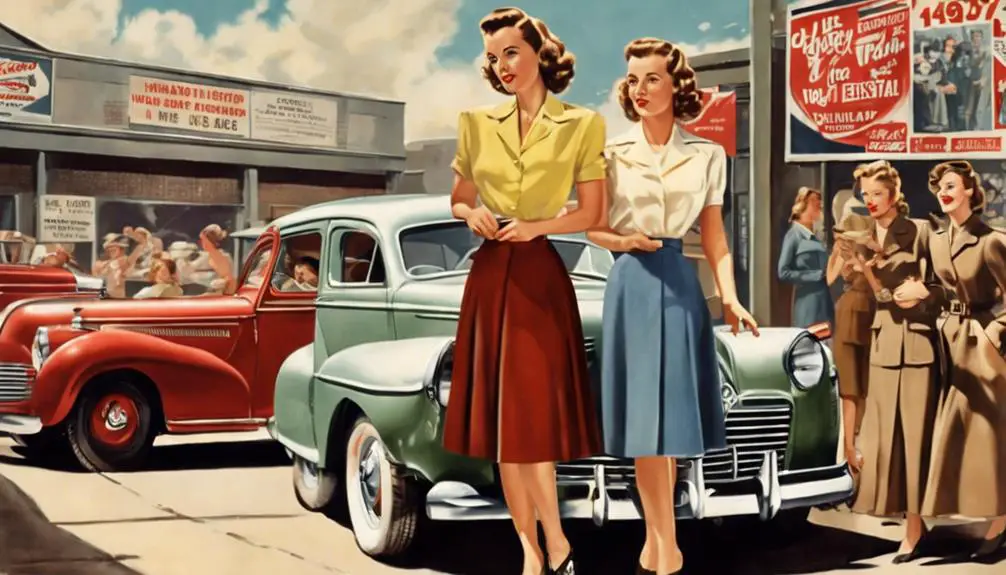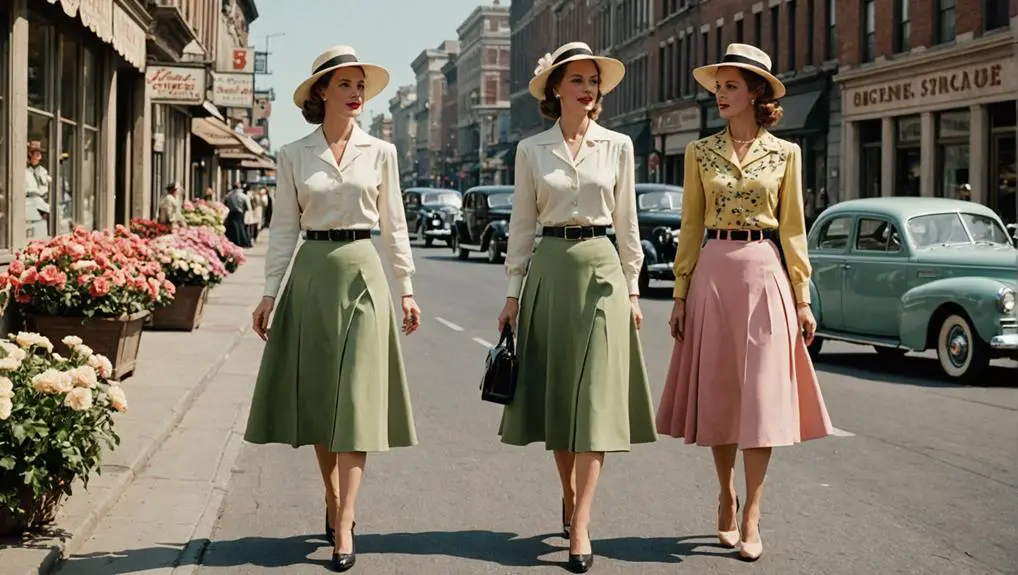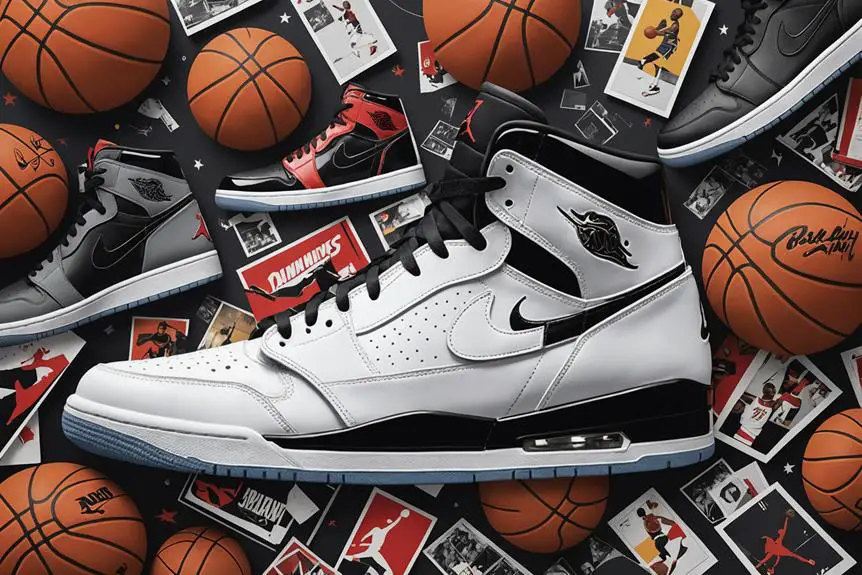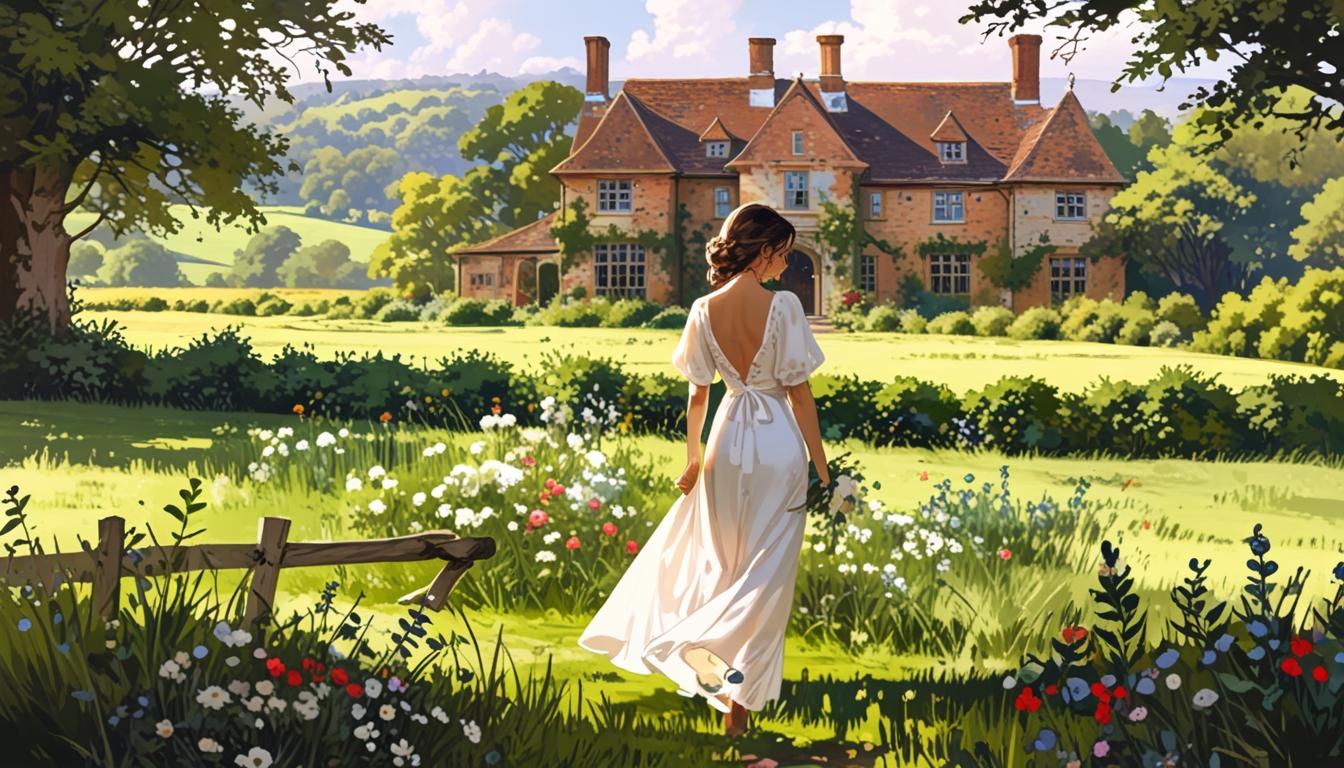In the 1940s, women's skirts underwent notable transformations shaped by wartime fabric shortages and post-war optimism. During the war, skirts were simplified, featuring muted colors, knee-length hemlines, and minimal fabric to conserve resources. Post-war fashion brought freedom, with full circle and pleated skirts emerging as symbols of joy, often in vibrant hues and lively patterns like dirndl designs. Fabrics evolved too, shifting from wool blends to lighter cottons. These trends not only reflected the era's social shifts but also laid the groundwork for lasting inspirations in fashion. Discover more about how these styles influence today's trends.
Wartime Skirt Styles

During the wartime period from 1941 to 1944, women's skirt styles underwent a significant transformation, reflecting the broader societal changes brought on by fabric rationing. You'd notice that skirts became simpler, with a ban on frills and ruffles. Hemlines rose to just below the knee, emphasizing a practical aesthetic that suited the times. The maximum width of skirts was limited to just 2 inches, ensuring that materials were conserved. This shift in fashion was also influenced by the need for functionality, as women took on more roles in the workforce. Common fabrics like wool and rayon blends dominated the vintage wardrobe, while lighter options such as cotton poplin offered a summer alternative. The color palette leaned towards drab shades of blue, grey, green, and brown, mirroring the somber mood of the era. As the war progressed, pleats gained traction, introducing styles like knife and box pleats that added a touch of sophistication. High-waisted designs became popular, accentuating the waist while maintaining the knee-length cut. These wartime styles not only reflected the constraints of fabric availability but also revealed the resilience and adaptability of women during challenging times, showcasing their ability to maintain elegance amid adversity. Additionally, understanding the historical context of vintage clothing labels can enhance appreciation for these iconic designs.
Post-War Fashion Trends
Revitalization marked the fashion landscape in the immediate post-war years, as skirt designs from 1945 to 1949 embraced a newfound sense of freedom and expression. The shift from wartime simplicity to vibrancy was evident in the introduction of full circle skirts and pleated skirts, which enhanced swing and movement. This dramatic transformation reflected society's desire for comfort and femininity, eliminating the need for petticoats.
Dior's New Look, revealed in 1947, revolutionized the standard by introducing midi lengths and exaggerated volume, incorporating large patch pockets into designs. Bright colors like yellow, green, aqua, and royal blue emerged, symbolizing the optimism that followed the war. Teens gravitated toward playful vintage inspired clothing, often opting for vibrant tartans and polka dot patterns paired with crisp white blouses, creating a youthful aesthetic.
As you explore the late 1940s, you'll notice the full circle skirt's popularity, which offered both style and ease. The era's focus on personal expression through fashion marked a significant departure from the restrictions of the past, paving the way for future trends while celebrating a new chapter in women's fashion.
Dirndl Skirts and Summer

The allure of dirndl skirts in the summer of the 1940s showcased a vibrant departure from the somber tones of wartime fashion. These knee-length, A-line skirts became a symbol of post-war optimism, embodying a playful spirit that women enthusiastically embraced. As you chose your summer attire, dirndl skirts offered a invigorating contrast to the muted colors of rationed styles, inviting you to express your individuality.
Often adorned with folk patterns, these skirts added a cheerful element to your wardrobe, making them perfect for sunny outings. The absence of ruffles and excessive trims in wartime skirts made dirndl skirts appealing for their decorative elements, allowing you to enjoy a more whimsical aesthetic. U.S. designers, inspired by global influences, helped popularize this peasant style, solidifying the dirndl as a summer staple.
With vibrant hues and delightful border print fabrics, dirndl skirts not only enhanced your visual appeal but also acted as a celebration of freedom and creativity. As you twirled in these skirts, you felt the joy of summer, a playful reminder of the brighter days ahead after years of hardship.
Fabrics and Patterns
As fashion shifted away from wartime constraints, the fabrics and patterns of the 1940s reflected a newfound sense of freedom and creativity. Early in the decade, wool and rayon blends dominated skirts, primarily due to fabric rationing. However, as the war ended, lighter materials like cotton poplin became increasingly popular for summer wear.
The color palette during the 1940s began with earthy, muted tones such as blues, greys, and greens, gradually evolving to more vibrant shades like yellow and aqua in the post-war years. Patterns also progressed; skirts featured classic designs like plaids, polka dots, and stripes. By the latter half of the decade, bold prints like houndstooth and gingham emerged, offering fresh options for the style-conscious woman.
Dirndl skirts, characterized by their knee-length A-line designs and vibrant floral prints, marked a bold departure from the simpler wartime styles. The introduction of pleated midis added movement and flair, showcasing the era's embrace of creativity. Overall, the 1940s skirts encapsulated a blend of practicality and artistic expression, setting the stage for future fashion innovations.
Lasting Influence on Fashion

Fashion enthusiasts and designers alike continue to feel the lasting influence of 1940s skirts, which have carved out a timeless niche in contemporary wardrobes. The pleated A-line skirt, a hallmark of that era, remains a classic design, inspiring modern adaptations that blend nostalgia with current trends. High-waisted skirts and full skirts are now staples in many collections, showcasing the enduring appeal of vintage style.
Brands like Collectif and ModCloth celebrate authentic 1940s vintage-inspired looks, incorporating elements such as intricate pleats and bold patterns. These designs resonate with consumers drawn to the romanticism of past decades. You might find that maxi skirts, with their flowing silhouettes, also carry the essence of 1940s fashion, further highlighting how these vintage styles have been reimagined.
Thrift shops brim with authentic 1940s skirts, reflecting the ongoing fascination with vintage fashion among collectors and enthusiasts alike. The influence of this era extends beyond skirts, as cardigans and pullovers from the 1940s complement these vintage looks, solidifying their importance in your modern wardrobe. By embracing these styles, you can effortlessly blend the past with the present.
Modern Interpretations of 1940s Skirts
Drawing inspiration from the past, modern interpretations of 1940s skirts capture the essence of a bygone era while incorporating contemporary sensibilities. Today's fashion often embraces high-waisted designs, pleated details, and A-line silhouettes that echo the classic styles of the 1940s. You'll find that brands like Collectif and ModCloth offer vintage-inspired skirts that not only celebrate this nostalgic aesthetic but also serve practical needs, such as skirts with pockets.
These modern adaptations showcase a variety of styles, including the beloved skirt floral print, making them versatile for both everyday wear and themed events. The flattering nature of pleated A-line skirts means they suit a range of body types, appealing to a broad audience. Additionally, the enduring popularity of solid colors and plaid patterns reflects the timeless quality of 1940s skirts, blending historical influence with today's trends.
As you explore thrift shops, you may discover authentic pieces from that decade, further fueling the nostalgic appeal for vintage fashion. Ultimately, these contemporary iterations celebrate the rich heritage of women's fashion while ensuring practicality and style remain at the forefront.
Frequently Asked Questions
What Skirts Were Popular in the 40s?
In the 40s, you'd notice simple, knee-length skirts with limited widths, often in muted colors. As the decade progressed, pleated styles, particularly knife and box pleats, gained traction, reflecting changing fashion sensibilities and wartime influences.
How Long Were Skirts in the 1940s?
In the 1940s, skirts varied in length, starting just below the knee due to wartime restrictions. As the decade progressed, they evolved into longer midi styles, reflecting broader fashion trends and changing societal norms.
Where Were Women's Hemlines During Wartime in the 40s?
During wartime in the 40s, you'd notice women's hemlines rising to just below the knee. This change reflected fabric rationing, prioritizing practicality and simplicity, while influencing the overall fashion narrative of that era.
Did They Wear Petticoats in the 40s?
You'll find that petticoats were largely absent early in the 40s due to fabric rationing, but they re-emerged towards the decade's end, enhancing fuller skirts and becoming a popular accessory by the late 1940s.




